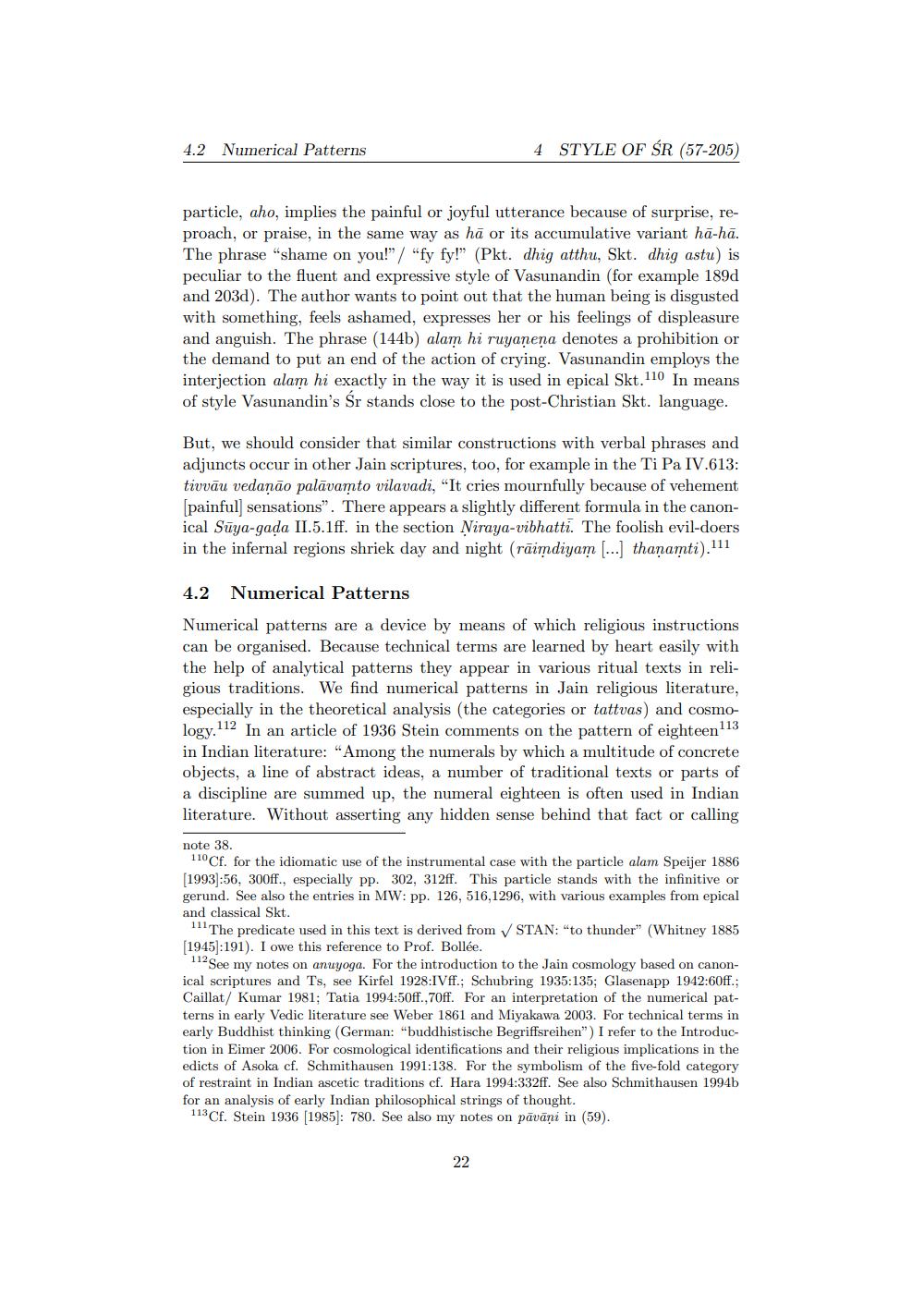________________
4.2 Numerical Patterns
4 STYLE OF ŚR (57-205)
particle, aho, implies the painful or joyful utterance because of surprise, reproach, or praise, in the same way as hā or its accumulative variant hā-hā. The phrase "shame on your"/ "fy fy!" (Pkt. dhig atthu, Skt. dhig astu) is peculiar to the fluent and expressive style of Vasunandin (for example 189d and 203d). The author wants to point out that the human being is disgusted with something, feels ashamed, expresses her or his feelings of displeasure and anguish. The phrase (144b) alam hi ruyanena denotes a prohibition or the demand to put an end of the action of crying. Vasunandin employs the interjection alam hi exactly in the way it is used in epical Skt. 110 In means of style Vasunandin's Śr stands close to the post-Christian Skt. language.
But, we should consider that similar constructions with verbal phrases and adjuncts occur in other Jain scriptures, too, for example in the Ti Pa IV.613: tivvāu vedação palavamto vilavadi, “It cries mournfully because of vehement [painful] sensations". There appears a slightly different formula in the canonical Suya-gada II.5.1ff. in the section Niraya-vibhatti. The foolish evil-doers in the infernal regions shriek day and night (räimdiyam [...] thanamti),111
4.2 Numerical Patterns
Numerical patterns are a device by means of which religious instructions can be organised. Because technical terms are learned by heart easily with the help of analytical patterns they appear in various ritual texts in religious traditions. We find numerical patterns in Jain religious literature, especially in the theoretical analysis (the categories or tattvas) and cosmology.112 In an article of 1936 Stein comments on the pattern of eighteen1 113 in Indian literature: "Among the numerals by which a multitude of concrete objects, a line of abstract ideas, a number of traditional texts or parts of a discipline are summed up, the numeral eighteen is often used in Indian literature. Without asserting any hidden sense behind that fact or calling
note 38.
110 Cf. for the idiomatic use of the instrumental case with the particle alam Speijer 1886 [1993]:56, 300ff., especially pp. 302, 312ff. This particle stands with the infinitive or gerund. See also the entries in MW: pp. 126, 516,1296, with various examples from epical and classical Skt.
The predicate used in this text is derived from ✓ STAN: "to thunder" (Whitney 1885 [1945]:191). I owe this reference to Prof. Bollée.
112 See my notes on anuyoga. For the introduction to the Jain cosmology based on canonical scriptures and Ts, see Kirfel 1928:IVff.; Schubring 1935:135; Glasenapp 1942:60ff.; Caillat/ Kumar 1981; Tatia 1994:50ff.,70ff. For an interpretation of the numerical patterns in early Vedic literature see Weber 1861 and Miyakawa 2003. For technical terms in early Buddhist thinking (German: "buddhistische Begriffsreihen") I refer to the Introduction in Eimer 2006. For cosmological identifications and their religious implications in the edicts of Asoka cf. Schmithausen 1991:138. For the symbolism of the five-fold category of restraint in Indian ascetic traditions cf. Hara 1994:332ff. See also Schmithausen 1994b for an analysis of early Indian philosophical strings of thought.
113 Cf. Stein 1936 [1985]: 780. See also my notes on pavāṇi in (59).
22




